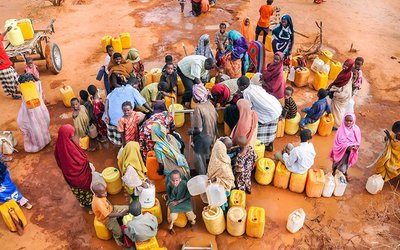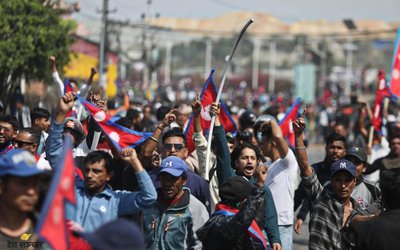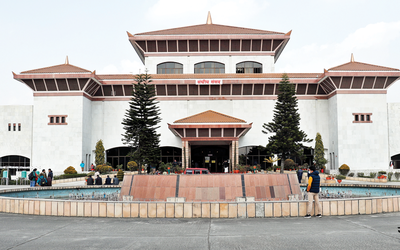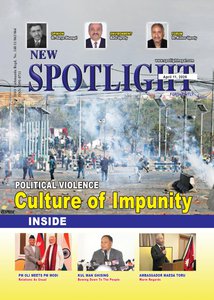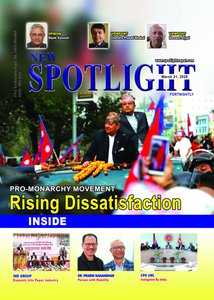
The present scenario
Inclusive development, which requires the meaningful engagement of previously under-served and ignored populations, such as poor and marginalized communities, is crucial. Adopting an inclusive approach ensures that once unreached segments of the population will participate in each stage of a development project and receive development benefits in a socially just fashion. An inclusive approach also addresses the specific needs of different groups, ensures equitable access to resources and opportunities, and fosters sustainable development outcomes. To maximize development benefits, inclusivity must be mainstreamed into project design, implementation and evaluation. Only if this an inclusive approach is adopted can we effectively address the challenges facing the poor and marginalized and achieve the goals of the 2030 sustainable development agenda.
The total population of the Pacific Island countries and territories (PICs) is 12.77 million. Of them, 48.76% are women and 35% are children under 15 (SPC-Pacific Data Hub, 2022). Another 15%, or 1.7 million, identify as persons with disabilities, and that number is expected to rise significantly. About3–5% identify as part of the LGBTIQ+ community. The UNDP's Governance for Resilient Development in the Pacific, a program supported by AusAid, KOICA, New Zealand's Foreign Affairs and Trade Aid Programme, and Sida, provides statisticsPICs. Over 60% of women and girls in PIC shave experienced physical and sexual domestic violence, and those with disabilities are two or three times more likely to be victims. Twice as many men as women have paid employment and women constitute just over 7% of PIC parliamentarians, the lowest rate in the world. Same-sex sexual conduct is criminalized in most PICs, with the exceptions of Fiji, Nauru, and Vanuatu. Although there is a visible LGBTIQ+ community, and traditional third-gender communities exist in Kiribati, Samoa, Tonga, and Tuvalu, evangelistic religious and conservative cultural values have seen a rise in discrimination against and stigmatization of these communities.
Why an inclusive approach is often not incorporated?
Despite many efforts from the government, non-government and UN agencies, inclusive approaches are often not incorporated into development initiatives. In the Pacific region, women encounter numerous obstacles to their participation and advancement in development initiatives, including gender inequality, economic disparities, limited educational opportunities, gender-based violence, restricted access to healthcare, and the disproportionate impacts of climate change and environmental degradation. In addition, cultural norms and traditional gender roles often prioritize men, limiting women's autonomy and agency, and economic disparities confine Pacific women to the informal sector, which is characterized by low wages and high job insecurity.
Despite recent progress, women and girls in the Pacific still face barriers to getting a good-quality education, including cultural norms, infrastructural limitations, and geographic isolation. Since they are not well educated, their skill development and participation in decision-making processes are limited. Gender-based violence is prevalent. It violates women's rights and undermines their wellbeing, mobility, and participation. Limited access to healthcare, particularly reproductive and maternal services, adversely affects women's health, further reducing their participation. The fact that women are disproportionately affected by climate change and environmental degradation exacerbates their existing vulnerabilities and hinder their involvement in efforts to promote climate resilience and sustainable resource management. Consequently, most development plans and programs inadequately address women’s issues and concerns, and they benefit less than men do from development initiatives.
Theories that advocate an inclusive approach to development
Several prominent scholars have formulated theories, including feminism, intersectionality, capability, and social constructionist, that serve as the foundation for comprehending and advancing an inclusive approach to development. These theories align well with (i) the 2050 Strategy for the Blue Pacific Continent and (ii) the Framework for Pacific Regionalism, which covers 22 regional networks. Feminism analyzes power dynamics and gender inequalities and advocates for empowering women and challenging traditional gender roles. Intersectionality highlights the overlapping effects of multiple forms of discrimination and informs strategies to address marginalization. Capability emphasizes removing structural barriers that limit the opportunities of marginalized groups. Social constructionism examines how social categories shape inequality and promotes inclusive policies.
In addition, several principles of development align with the inclusive approach: putting the last first (prioritizing marginalized groups), building from below (empowering communities to drive their development), listening to and learning from people (engaging people in participatory decision-making), and leaving no one behind (ensuring development reaches all).
These theories and principles contribute to inclusivity in development and ensure that projects are responsive to the realities and aspirations of the people they serve. Unfortunately, they have remained largely on paper.
Initiatives undertaken to expand the inclusive approach
International development banks such the World Bank and Asian Development Bank, along with bilateral agencies, UN bodies, particularly UNDP, the Secretariat of the Pacific Community (SPC), I/NGOs, and various forums and councils have initiated diverse programs and exemplary practices in the Pacific region to foster the inclusive approach. These initiatives focus on economic empowerment, political participation, and ending violence against women. UNDP has adopted gender-friendly policies and offered technical assistance to integrate gender-responsive budgeting, support women's political participation, and enhance gender-responsive development efforts. In addition, in 2017, UNDP established an institutional mechanism for gender mainstreaming: the UNDP Gender Equality Seal, which signifies UNDP's commitment to protecting and advancing women's rights and gender equality and encourages development organizations to integrate gender into all their work.
Taking one additional step, in January 2024, UNDP's Independent Evaluation Office introduced four key parameters—structure, methodology, data collection and analysis, and cross-cutting issues—to evaluate its development projects and programs. Under cross-cutting issues, it systematically evaluated five areas. First, it assessed 'leave no one behind' concerns, social and environmental safeguards, poverty/environment nexus, sustainable livelihoods, and human rights, especially of the disabled, minorities, and other vulnerable groups. Second, it ensured gender equality and women's empowerment were integrated into the scope, criteria, and methods of data collection. Third, it called the use of gender-responsive methodologies, tools, and data analysis techniques. Fourth, it assessed whether the findings, conclusions, and recommendations of evaluations included gender analysis. Last, it considered the inclusion of disability in interventions.
In its most recent Strategic Plan (2022–2031), the SPC included gender equality and social inclusion (GESI) as a sector and planned to achieve it using the following three pathways: (i) policy to action, (ii) innovation and research, and (iii) capability and influence. Specifically, the SPC works to achieve an inclusive approach by conducting economic empowerment initiatives, promoting leadership, and improving access to essential services like healthcare and education. The SPC also provides capacity-building support to governments, civil society organizations, and communities to strengthen legal frameworks and protect the rights of marginalized groups.
Various forums and councils, including Pacific Women Shaping Pacific Development, Pacific Disability Forum, Pacific Youth Council, Pacific Regional Rights Resource Team, and Pacific Islands Forum Secretariat, play pivotal roles in operationalizing inclusive approaches, and the SPC itself is the custodian of eight regional forums/councils which foster collaboration among governments, regional organizations, and development partners to advance inclusivity. Governance, one of the four key areas of the Framework for Pacific Regionalism, focuses on enhancing governance and accountability mechanisms while promoting inclusive and participatory governance. As part of inclusive development interventions, GESI is advanced through initiatives such as Pacific Women Shaping Pacific Development and the Pacific Disability Forum.
Existing challenges to and emerging gaps in the inclusive approach
The 2050 Strategy for the Blue Pacific Continent recognizes that systemic barriers hinder poor and marginalized communities and that numerous challenges have made it difficult to mainstream inclusion though all recognize it is essential for fostering equitable and sustainable development. Institutional barriers, for example, impede mainstreaming, as does the absence of strong leadership and commitment from policymakers. Without adequate political will, mainstreaming does not receive the necessary resources or attention. The implementation of gender action plans and social and environmental safeguards is not systematic and they get too few resources to easily operationalize them. Often, the budgets earmarked for these two areas are under spent or redirected to structural components. Oen Tongan woman said of this state of affairs that development actors do not focus enough on put policy provisions into practice and that women, since they lack technical and financial resources, are unable to help.
Since development practitioners and decision-makers have limited knowledge, skills, and capacity to effectively integrate an inclusive approach, there is a great disparity between policy intentions and on-the-ground implementation. Resistance to change, bureaucratic procedures, and rigid structures hinder the promotion of inclusivity within institutions. In the Republic of Marshall Islands, for example, projects have to rely on a single GESI officer to ensure inclusivity as most other project staff has not understood that inclusivity is everybody’s business.
The lack of sufficient local-level data and evidence on gender and social dynamics also challenges mainstreaming inclusivity as, without accurate information, it is difficult to identify and address the specific needs, priorities, and vulnerabilities of different groups. One Fijian official noted that the use of different tools, approaches, and formats caused confusion among practitioners and made it hard to enter local data into national portals.
Deep-rooted socio-cultural and social norms perpetuate gender inequality and exclusion and challenge efforts to women's empowerment and social inclusion. Limited financial resources and competing development priorities also constrain mainstreaming, especially as operationalizing inclusive approaches often requires additional funding for capacity-building, gender-responsive programming, and targeted initiatives. This money may not always be available. In the Federated State of Micronesia, one woman stakeholder appreciated being listened to closely but noted that not all locals’ concerns were included in action plans and that even good action plans often could not be implemented due to resource constraints.
Inadequate coordination and collaboration among different stakeholders and sectors undermine mainstreaming, which depends on multisectoral partnerships, coordination mechanisms, and collaboration across development agencies. In Kiribati, one interviewee claimed that GESI issues were subjective, non-structural and often invisible and that donors pressurized implementing agencies to increase the burn rate of budgets, thereby forcing them to focus tangible and structural activities at the expense of social activities and inclusion.
The path ahead
The following seven steps should be taken to operationalize the inclusive approach.
Step1: Assist in developing inclusive policies and operationalizing policy provisions
Provide assistance in developing and implementing policies by formulating legal frameworks and toolkits under the leadership of government and development actors. Support the translation of policy provisions into action by training officials, particularly women; integrate an inclusive approach into national development plans and sect oral policies; establish specialized GESI units; engage relevant stakeholders in governance at the national, regional, and local levels; advocate for inclusive plans and programs; and manage the technical and financial resources needed to operationalize inclusive policies.
Step2: Craft gender-responsive programs congruent with policy provisions
To translate policy provisions into reality, develop and implement inclusive activities in all phases of project’s lifecycle in coordination with stakeholders. Conduct inclusive gender assessments, integrate gender analysis into project designs, establish gender-sensitive targets and indicators, adopting gender-responsive approaches in interventions ad activities, and enhancing capacities in GESI analysis and the intersectionality of vulnerabilities. To align with the 2050 Strategy for the Blue Pacific Continent, mainstream GESI across all sectors; break down silos and foster collaborative efforts; formulate regional actions reflecting the diverse contexts and realities of the Pacific; embed GESI in regional policies and initiatives; and advocate for a strong, unified voice in international forums on issues such as climate change, trade, and development aid.
Step 3: Develop inclusive plans and manage enough budget to implement them
Under the leadership of government and development actors, develop evidence-based inclusive planning and budget by conducting scenario-based costing exercises during project formulation. Analyze budgets to identify and rectify gender gaps, allocating funds to advance inclusive development, and monitor expenditures to ensure that resources are distributed fairly, especially to marginalize groups are addressed. Make it mandatory that installment disbursement is contingent on progress in a project’s gender action plan and social and environmental safeguards.
Step4: Impart capacity-building and awareness actions to contribute to implementation
Enhance the capabilities of organizations that advocate for the inclusive approach. Utilize women's safety audits to heighten awareness and create platforms for stakeholders to evaluate safety and security measures. Promote knowledge-building and awareness. Disseminate policy provisions through mass awareness campaigns such as radio public service announcements, rallies, and social media initiatives. Provide training on mitigating gender-based violence to government stakeholders, development actors, and project staff. Teach that the inclusive approach is everybody’s business.
Step5: Gather gender-responsive data through uniform tools and formats
Enhance gender- and inclusion-responsive data collection and analysis to facilitate evidence-based decision-making, and monitor progress by integrating gender- and inclusion-sensitive indicators into monitoring frameworks, collecting disaggregated data, providing training on monitoring frameworks, and developing standardized tools to streamline local data within national portals. Good-quality data produces evaluations that generate learning.
Top of Form
Step6: Manage knowledge and disseminate it to promote wide replication
Promote knowledge management by conducting gender audits and evaluations and making stakeholders accountable for achieving objectives. Provide brief, periodic training sessions to enhance the capacity of community members, project staff, government officials and development actors. Conduct regular review-and-reflection sessions to track progress and address gaps. Offer small research grants to university students to produce concise case studies about inclusive development. Produce two-page policy briefs outlining the provisions in various inclusive development policies and distribute them in the form of posters, flyers, tips, and case studies.
Step7: Document learning and good practices while designing the next round of projects
Involve project teams and communication sections in documenting good practices and lessons learned, and triangulate those lessons during evaluations. Share lessons with government stakeholders and disseminate them to relevant actors at a learning workshop. Use that learning to craft the next round of similar projects so that inclusive approaches fertilized at higher levels, too.
Authors

Dr. Dhruba Gautam is an independent evaluator and researcher specializing in natural resource management, climate, and disaster resilience in the Asia-Pacific region. He can be reached at drrgautam@gmail.com.

Bhakta Bahadur Karki is a development practitioner with over 15 years of experience in inclusive development initiatives. He currently serves as the Knowledge, Research, and Innovation Management Adviser in the Human Rights and Social Development Division of the Pacific Community (SPC) in Suva, Fiji. He can be reached at bhakta.karki1983@gmail.com.)

